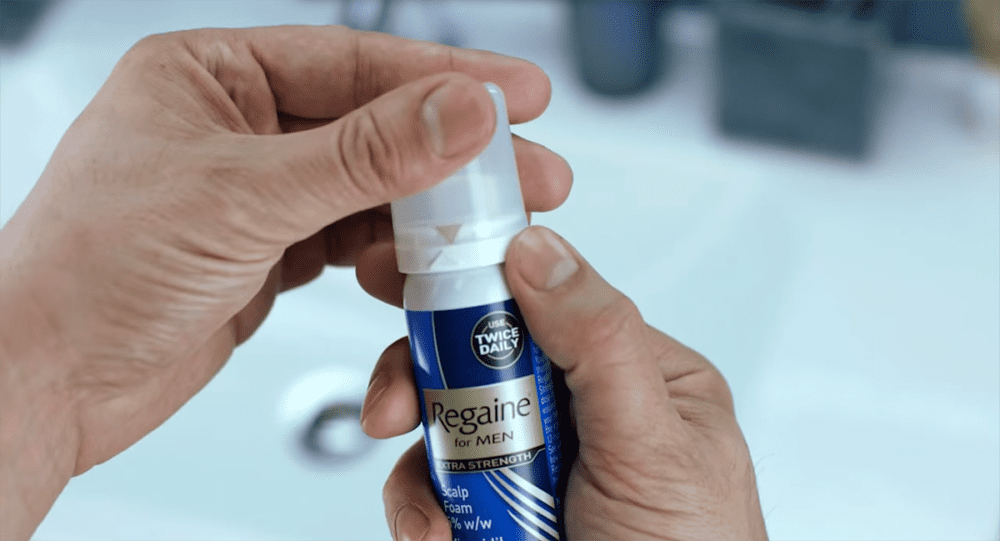Male Pattern Baldness: An Honest Guide By A Hair Loss Expert
Unfortunately, we men were not all destined to sport a thick head of glossy hair for our entire lives. If you’re reading this, you’re probably one of those hapless chaps who can’t seem to keep a hold of his hair. For you, every strand is precious. I know; I was in that club too. The terms “male pattern baldness” and “receding hairline” are enough to send some curling into the foetal position, longing for those pre-twenties days when hair loss wasn’t on the horizon.
If only we could all be so bold as to face the mirror with Herculean bravery every morning. There are those who rock a chrome dome like it’s the shiny bonnet of a magnificent muscle car. But for most of us, watching the depletion escalate without any sign of stopping is a miserable, depressing affair.
The alpha-ness of the balding man

Jason Statham owning a shaven head
I know it’s going to seem a bit like empty consolation for you but numerous research studies have proven that men with male pattern baldness, or androgenic alopecia, are often considered to be more intelligent, more attractive, more trustworthy and more socially adaptable. The bald man’s social dominance is well represented in popular culture: Dwayne “The Rock” Johnson is an indisputable alpha male, an all-round good guy who rakes in the big bucks and hasn’t a hair on his head. Same goes for Jason Statham, Stanley Tucci, Samuel L. Jackson, Vin Diesel…. the list goes on. Would you ever question the virility or manliness of former pro basketballers Shaquille O’Neal and Michael Jordan, or boxing champs Floyd Mayweather and Mike Tyson? No. Therefore, you cannot use your male pattern baldness as an excuse to be anything less than the man you want to be.
However, whether it’s due to confidence issues or you simply don’t like the shape of your skull, let’s take a look at the facts and potential remedies to male pattern hairloss – if, in fact, you do truly want to retain the hair you have left.
What gives with the hair loss?
Hardworking scientists have invested serious time, money and brain power into finding out why male pattern baldness occurs. It simply comes down to two things: your genetic makeup and a chemical imbalance. If your levels of the hormone DHT are out of whack, and you have bald men in your family, baldness is likely coming for you.
The job of DHT, or dihydrotestosterone if you really want to get technical, is to develop and maintain the sexual characteristics of a man. It really kicks in at puberty when all that wondrous facial and body hair starts to appear.
The WTF about DHT
Oh, the irony! While DHT helps to grow hair on some parts of the body, the same hormone is responsible for hair loss on the top of your head. That’s why a lot of bald men are really hairy, with great, full beards and comb-able backs. The thing is, if your genes lean towards hair loss, what’s occurring is your DHT is binding to the receptors in your hair follicles, causing them to shrink, become weak and, ultimately, die. It’s what’s known as “miniaturisation”.
Proven Ways To Prevent Hair Loss
Now that you understand DHT’s role, you’ll be able to understand that the way to prevent or slow hair loss is to block DHT. You have two main choices: block DHT at the source, or increase blow flow to the hair follicles. For the former, the drug Finasteride (branded as Propecia) is quite successful at blocking the conversion of testosterone to DHT, and preventing the production of DHT altogether.
Option 1: FDA-Cleared Kiierr Laser Cap
The Kiierr Laser Caps use premium laser diodes (650nm wavelength) to treat thinning and balding hair which helps reverse hair loss. It also promotes healthier, thicker hair follicles – in a safe and effective, easy, portable and discreet cap for treating hair loss. It will also revitalise damaged and or frail hair. And rest assured, the caps are FDA cleared with no reported side effects.
Just place the cap comfortably on your head and push the on button to begin your session. The laser cap will automatically turn off when finished its magic using scientifically proven LLLT technology to regenerate your hair follicles giving them increased energy and blood flow, in just 30 minutes per day.
Option 2: Finasteride

Finasteride 1mg (widely branded as Propecia) is the only FDA-approved oral treatment for hair loss, and it requires a prescription from a certified medical professional. It’s taken once per day and clinical trials have shown it promotes hair growth in about 66% of individuals after two years of treatment. Approximately 83% of individuals on the treatment maintain their existing hair after two years as well.
I have personally responded incredibly well to the medication and have now been on it for 16 years. It immediately stopped any further progression of hair loss and thickened up the entire mid- and crown region. I’m thankful I’ve responded well, because Finasteride is ultimately the secret to my overall success in fighting and beating hair loss.
How Does It Work?
Finasteride works by blocking the enzyme 5-alpha reductase, which is responsible for converting testosterone to DHT, therefore causing a significant drop in both scalp and blood levels of DHT. Finasteride (1mg/day) is proven to decrease serum DHT levels by almost 70%.
Option 3: Minoxidil

1 Month/ 60g Supply Rogaine 5% Foam for Men, £22.95 >
Minoxidil (branded as Rogaine in the US and Regaine) stimulates hair follicles by reversing miniaturisation, increasing blood flow around the follicles, stimulating follicle development from dormant to active hair growth and extending each follicle’s growth phase.
This is a topical treatment (one that you rub into the scalp), which is licensed for the treatment of male pattern baldness globally. It was originally developed (in tablet form) as a drug for high blood pressure. Doctors began to noticed that people on minoxidil sometimes grew new hair, so the drug was reformulated for this purpose. Regaine comes as 2% or 5% lotions and foams which you rub, twice daily, into your scalp. In the UK, Regaine is an over-the-counter medicine, which means you can obtain it from a pharmacy without a prescription.
It’s important to keep in mind that both Finasteride and Minoxidil are extremely effective at preserving existing hair, but it’s not certain that they can halt hair loss altogether. It’s also a long-term financial and emotional commitment: stop using them and you will revert back to your natural stage of hair loss, losing any hair you may have regrown. That said, used together they are certainly the best proven defence against DHT and, in turn, male pattern baldness.
Ways To Disguise Hair Loss
Hair Prosthesis
Do you really want to explore wigs and toupees? Probably not. But you might want to investigate the latest hair replacement system, called Capelli Natural a Contatto. It’s a hair prosthesis that’s so realistic, it’s said to be “a perfect replica of a person’s scalp”, whether partial or full. The name is Italian for “Natural Contact” Hair, or CNC for short. It’s fully bespoke so it’s quite expensive, but the difference in quality between CNC and traditional cover-ups is night and day.
Scalp Micro Pigmentation

Spex undergoing Advanced Tricho Pigmentation (ATP)
This is essentially a hair tattoo. It sounds ridiculous, but when performed correctly with the right inks and a skilful technician it can give you a fantastic appearance of hair stubble. However, in the wrong hands (like any treatment) it can look unnatural so you need to be wary and do your research before committing.
Scalp micropigmentation is ideal for those that want the appearance of a close buzz cut, but it can also work well to add density to existing hair in thinner areas and is brilliant at camouflaging scars on the head. I’ve had it performed on my old strip scars from previous hair transplants and it gave me the confidence to wear my hair shorter.
The Last Resort: Surgical hair transplants
In this procedure, your functioning hair follicles are implanted on to the top of your head. Once implanted, they will continue to perform the same as they did in their original location. Now, I’ve had 13 hair transplants and what I want you to know most of all is that you must not go ahead with hair transplantation unless you’ve done some serious research. The success of your procedure – as well as your overall health and safety – depend on the quality and experience of the surgeon and the clinic you choose. It is a minefield out there, and unfortunately has never been as unsafe due to all the inexperienced clinics claiming to be the best and offering “cheap” deals. Do your due diligence. Surgery should always be a last resort.
Don’t throw good money after bad
Believe me, I know – you want results and you want them to be outstanding. So don’t be a tight-ass and hand over your money to the first charlatan that looks at you sideways. Don’t believe everything you’re told; it pays to be sceptical when it comes to your health. Stick to science, stick to reputable providers and give the so-called “natural” remedies a big swerve.
Want to know who I’d recommend?

In Pursuit Of The Perfect Hairline – an article by Spex on Ape to Gentleman (click the image to read more)
We need to make sure patients are safe and protected from the vicious hands of the industry and fortunately there are ethical organisations working hard in this space alongside caring experienced physicians who are doing an amazing job fighting the good fight. One such team is FUE Europe and the International Alliance of Hair Restoration Surgeons (IAHRS), headed up by world-leading surgeons Dr. John Cole and Dr. Christian Bisanga as well as the founder of IAHRS, Spencer Kobren. For anyone living under a rock and just starting out in the world of researching hair loss you are pretty much dealing with the Harlem Globetrotters of hair here.
If I were to give one piece of advice to potential transplanters, it would be: do your research online and face to face and not via social media adverts. Drop by your preferred clinic and chat to the doctor in person to find out as much as you can about the way they like to work and meet their patients in the flesh. Try to gather as much intel as you can, so you can make an educated decision.
Spencer Kobren and Joe Tillman, via the radio show The Bald Truth, are two other individuals on a labour intensive mission to serve and protect weekly, and we would wholeheartedly recommend you tune into this unique show and get armed and informed with the right information. There are good people in this space and you need listen to what they are preaching.
Who to avoid like the plague
You know those TV shopping network spots that promise the world? Yeah, those. Don’t bother. You know those social media ads that guarantee you’ll grow back your hair with this or that product or your money back? Again, don’t bother. Oh and you know those juicy celebrity endorsements? Ha! Consider this: if that celeb had plenty going on, would he be wasting his time on a hair replacement ad?
And one more thing: for the love of god, don’t get suckered in to one of those slick hair tourism offers. These guys swindle you for a trip to Turkey where you’ll supposedly get your surgery, hot nurses at your beck and call, free air travel and even a brand new carry-on case. Come on – if an offer is too good to be true, it almost always is.
Hair replacement surgery is a last resort
It can be tempting to think hair surgery will be the answer to all your problems, but try some less drastic options first. Hair replacement surgery is expensive, uncomfortable-to-painful and the results – for better or worse – are permanent. Get it right and it could be transformative for your self-esteem and confidence, but it’s important to understand you will likely need to have further work down the line once your hair loss progresses further (and it will). Get it wrong and you are setting yourself up for a great deal of anxiety, frustration and isolation – no one wants to be labelled the guy that got the bad hair transplant.
Ask yourself these 4 important questions
- Am I actually going bald or is my hair receding? If your hair is thinning around the temples and the crown, then it’s probably male pattern baldness. If you’re losing the hair on your head plus hair on your body, it could be alopecia. It’s not a serious disease and it’s extremely common, but it won’t respond to any of the aforementioned treatments.
- Will I get actual depression from hair loss? Not if you don’t let yourself. When all’s said and done, it’s just hair. I know it can be devastating but if you feel like you’re spiralling, you should seek medical attention promptly.
- Am I seriously ill? In most cases, no. Hair loss is extremely common. Still, see your doctor for a physical and see what shows up. You could have a scalp infection, you could be losing your hair due to trauma or stress, or you could be experiencing hormonal changes.
- Am I going to lose my facial hair and body hair too? Nope. Male pattern baldness only affects hairs on the scalp.
- Why am I losing my hair? If you’re in your twenties, and baldness runs in your family, you could be a real candidate for male pattern baldness. Don’t panic, get educated and informed as there are resources to help you that are safe. If you wish to take action against it – you can.
Remember: You’re not alone
Whatever you’re going through, just know you’re not going through it alone. If more men would talk about their balding concerns, there’d be far less worry and stigma attached to it. Book in with your GP if it’s really bothering you and let that be your starting point towards any treatment options. You can Google whatever you like but just beware that “Dr Google” can be a fickle bastard. One minute you’re looking up “male pattern baldness”, the next you’re panic-stricken at all the mentions of cancer and impotence. Fear not; get properly informed and take thoughtful steps on your journey to discovering your specific causes and your specific remedies.








